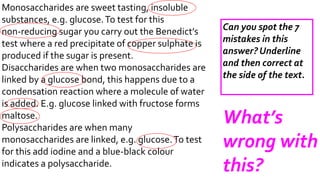The document summarizes carbohydrate digestion. It states that salivary amylase in the mouth begins breaking down starch into maltose. In the small intestine, pancreatic amylase further breaks down starch and maltase breaks down maltose into glucose. The small intestine also secretes sucrase and lactase to break down sucrose into glucose and fructose and lactose into glucose and galactose, respectively. Lactose intolerance occurs when people lack sufficient lactase as adults to digest lactose from milk.











